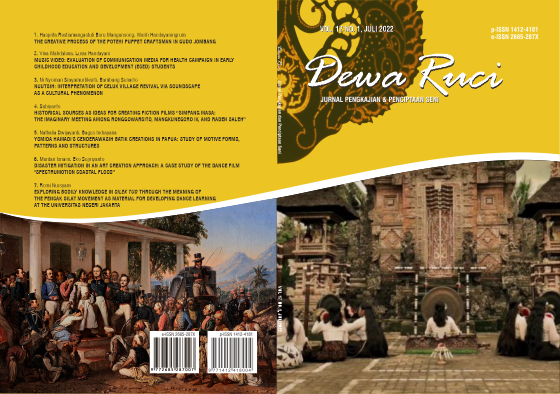Exploring bodily knowledge in Silek Tuo through the meaning of the Pencak silat movement as material for developing dance learning at the Universitas Negeri Jakarta
DOI:
https://doi.org/10.33153/dewaruci.v17i1.3526Keywords:
Silek Tuo, Bodily knowledge, Pencak silat, Dance learning, PaninggahanAbstract
Silat, apart from being a form of self-defence, is also a source of artistic inspiration for dance artists, including, in this case, Silek Tuo, which developed in Paninggahan, which is the “Parik Paga Nagari” (village protector). The purpose of the study was to find out and describe the meaning that existed in the Silek Tuo element, where the study included the conditions that must be fulfilled before the Silek Tuo practice, the meaning of the Silek Tuo itself from an Islamic perspective, and the meaning of the Silek Tuo movement, which would be applied in Pencak silat courses at the Dance Study Program at Jakarta State University. The method used in the research is the descriptive qualitative method, where the meaning of Silek Tuo is described in writing, with the method of collecting data using observation and interviews. The urgency of this research is to improve dance students' psychomotor affective and cognitive abilities about silat, especially the Silek Tuo. This study's results describe the conditions that must be met to learn Silek Tuo, the meaning of motion, and the correlation of Islamic law to Silek Tuo in PaninggahanDownloads
References
J. Hadler, “A historiography of violence and the secular state in Indonesia: Tuanku Imam Bondjol and the uses of history,” J. Asian Stud., vol. 67, no. 3, pp. 971–1010, 2008. doi: 10.1017/S0021911808001228
S. Anwar, I. Aziz, and D. Susanti, “Preserving the Value of Minangkabau Culture Through Local Wisdom-Based Education,” in Proceedings of the 4th Padang International Conference on Education, Economics, Business and Accounting (PICEEBA-2 2019), 2020, pp. 495–500, doi: 10.2991/aebmr.k.200305.110.
V. J. Konecni, “The aesthetic trinity: Awe, being moved, thrills,” Bull. Psychol. Arts, vol. 5, no. 2, pp. 27–44, 2005. doi: 10.1037/e674862010-005
D. F. Draeger, Draeger: Pioneering Leader in Asian Martial Traditions. Via Media Publishing, 2016. Available at: Google Books.
J. Desmond, Meaning in motion: New cultural studies of dance. Duke University Press, 1997. doi: 10.2307/j.ctv11sn2b4
N. L. Stein and L. J. Levine, “Thinking about feelings: The development and organization of emotional knowledge,” in Aptitude, learning, and instruction, Routledge, 2021, pp. 165–198. Available at: Google Scholar.
J. B. Thomas, S. M. Clark, and D. A. Gioia, “Strategic Sensemaking and Organizational Performance: Linkages Among Scanning, Interpretation, Action, and Outcomes,” Acad. Manag. J., vol. 36, no. 2, pp. 239–270, Apr. 1993, doi: 10.5465/256522.
M. Deuze, “Media life,” Media, Cult. Soc., vol. 33, no. 1, pp. 137–148, Jan. 2011, doi: 10.1177/0163443710386518.
M. Sayuti, “‘Alam Takambang Jadikan Guru’ (AJTG) Learning Model of Budaya Alam Minangkabau (BAM),” in Proceedings of the 3rd International Conference on Language, Literature, and Education (ICLLE 2020), 2020, doi: 10.2991/assehr.k.201109.044.
J. S. Phinney, “Stages of Ethnic Identity Development in Minority Group Adolescents,” J. Early Adolesc., vol. 9, no. 1–2, pp. 34–49, Feb. 1989, doi: 10.1177/0272431689091004.
D. Jacobson and N. Mustafa, “Social Identity Map: A Reflexivity Tool for Practicing Explicit Positionality in Critical Qualitative Research,” Int. J. Qual. Methods, vol. 18, p. 160940691987007, Jan. 2019, doi: 10.1177/1609406919870075.
T. I. Bayer, “Art as symbolic form: Cassirer on the educational value of art,” J. aesthetic Educ., vol. 40, no. 4, pp. 51–64, 2006. doi: 10.1353/jae.2006.0029
G. Barton, “Literacy and the Arts: Interpretation and Expression of Symbolic Form,” in Literacy in the Arts, Cham: Springer International Publishing, 2014, pp. 3–19. doi: 10.1007/978-3-319-04846-8_1
G. Franzenburg, “The Art of Intersubjective Dialogue: How to Make Partnership Sustainable,” Discourse Commun. Sustain. Educ., vol. 12, no. 2, pp. 54–61, 2021. doi: 10.2478/dcse-2021-0016
C. Heath, P. Luff, D. Vom Lehn, J. Hindmarsh, and J. Cleverly, “Crafting participation: designing ecologies, configuring experience,” Vis. Commun., vol. 1, no. 1, pp. 9–33, Feb. 2002, doi: 10.1177/147035720200100102.
R. Ingarden, “Aesthetic experience and aesthetic object,” Philos. Phenomenol. Res., vol. 21, no. 3, pp. 289–313, 1961. doi: 10.2307/2105148
C. K. Trizkyana and S. Siswantoyo, “Learn Pencak Silat Like Write a Book,” in Proceedings of the Conference on Interdisciplinary Approach in Sports in conjunction with the 4th Yogyakarta International Seminar on Health, Physical Education, and Sport Science (COIS-YISHPESS 2021), 2022, pp. 328–332, doi: 10.2991/ahsr.k.220106.061.
J. C. Cirlot, Dictionary of symbols. Routledge, 2006. doi: 10.4324/9780203133750
R. A. Rubinstein, “Culture and negotiation,” in The Struggle for Peace, University of Texas Press, 2021, pp. 116–129. doi: 10.7560/765412-010
I. Indrayuda and M. E. Samsuddin, “Changes in Form and Style in Randai Performance at The Minangkabau Diaspora in Malaysia,” Harmon. J. Arts Res. Educ., vol. 21, no. 2, pp. 340–355, Jan. 2022, doi: 10.15294/harmonia.v21i2.32043.
J. Savulescu, “Moral Status of Enhances Beings: What Do We Owe the Gods?,” Human enhancement. OUP Oxford, pp. 211–247, 2009. Available at: Google Scholar.
Downloads
Published
Issue
Section
License
Authors who publish in Dewa Ruci: Jurnal Pengkajian dan Penciptaan Seni agree to the following terms:
- Authors retain copyright and grant the Dewa Ruci: Jurnal Pengkajian dan Penciptaan Seni right of first publication with the work simultaneously licensed under a Creative Commons Attribution License (CC BY-SA 4.0) that allows others to share (copy and redistribute the material in any medium or format) and adapt (remix, transform, and build upon the material) the work for any purpose, even commercially with an acknowledgment of the work's authorship and initial publication in Dewa Ruci: Jurnal Pengkajian dan Penciptaan Seni.
- Authors are able to enter into separate, additional contractual arrangements for the non-exclusive distribution of the journal's published version of the work (e.g., post it to an institutional repository or publish it in a book), with an acknowledgment of its initial publication in Dewa Ruci: Jurnal Pengkajian dan Penciptaan Seni.
- Authors are permitted and encouraged to post their work online (e.g., in institutional repositories or on their website) prior to and during the submission process, as it can lead to productive exchanges, as well as earlier and greater citation of published work (See The Effect of Open Access).
This work is licensed under a Creative Commons Attribution 4.0 International License












